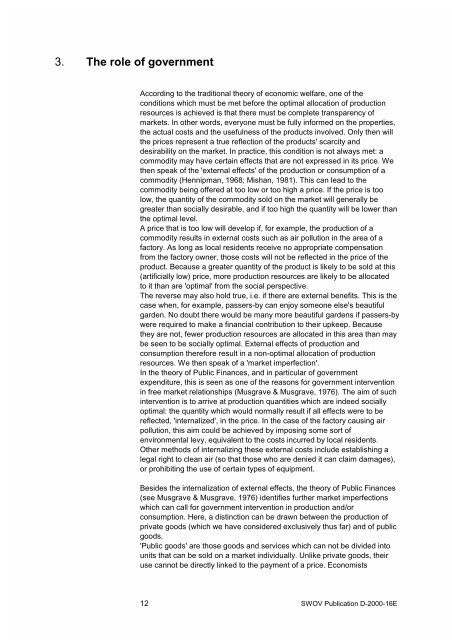Economic evaluation of road safety measures - Swov
Economic evaluation of road safety measures - Swov
Economic evaluation of road safety measures - Swov
Create successful ePaper yourself
Turn your PDF publications into a flip-book with our unique Google optimized e-Paper software.
3. The role <strong>of</strong> government<br />
According to the traditional theory <strong>of</strong> economic welfare, one <strong>of</strong> the<br />
conditions which must be met before the optimal allocation <strong>of</strong> production<br />
resources is achieved is that there must be complete transparency <strong>of</strong><br />
markets. In other words, everyone must be fully informed on the properties,<br />
the actual costs and the usefulness <strong>of</strong> the products involved. Only then will<br />
the prices represent a true reflection <strong>of</strong> the products' scarcity and<br />
desirability on the market. In practice, this condition is not always met: a<br />
commodity may have certain effects that are not expressed in its price. We<br />
then speak <strong>of</strong> the 'external effects' <strong>of</strong> the production or consumption <strong>of</strong> a<br />
commodity (Hennipman, 1968; Mishan, 1981). This can lead to the<br />
commodity being <strong>of</strong>fered at too low or too high a price. If the price is too<br />
low, the quantity <strong>of</strong> the commodity sold on the market will generally be<br />
greater than socially desirable, and if too high the quantity will be lower than<br />
the optimal level.<br />
A price that is too low will develop if, for example, the production <strong>of</strong> a<br />
commodity results in external costs such as air pollution in the area <strong>of</strong> a<br />
factory. As long as local residents receive no appropriate compensation<br />
from the factory owner, those costs will not be reflected in the price <strong>of</strong> the<br />
product. Because a greater quantity <strong>of</strong> the product is likely to be sold at this<br />
(artificially low) price, more production resources are likely to be allocated<br />
to it than are 'optimal' from the social perspective.<br />
The reverse may also hold true, i.e. if there are external benefits. This is the<br />
case when, for example, passers-by can enjoy someone else's beautiful<br />
garden. No doubt there would be many more beautiful gardens if passers-by<br />
were required to make a financial contribution to their upkeep. Because<br />
they are not, fewer production resources are allocated in this area than may<br />
be seen to be socially optimal. External effects <strong>of</strong> production and<br />
consumption therefore result in a non-optimal allocation <strong>of</strong> production<br />
resources. We then speak <strong>of</strong> a 'market imperfection'.<br />
In the theory <strong>of</strong> Public Finances, and in particular <strong>of</strong> government<br />
expenditure, this is seen as one <strong>of</strong> the reasons for government intervention<br />
in free market relationships (Musgrave & Musgrave, 1976). The aim <strong>of</strong> such<br />
intervention is to arrive at production quantities which are indeed socially<br />
optimal: the quantity which would normally result if all effects were to be<br />
reflected, 'internalized', in the price. In the case <strong>of</strong> the factory causing air<br />
pollution, this aim could be achieved by imposing some sort <strong>of</strong><br />
environmental levy, equivalent to the costs incurred by local residents.<br />
Other methods <strong>of</strong> internalizing these external costs include establishing a<br />
legal right to clean air (so that those who are denied it can claim damages),<br />
or prohibiting the use <strong>of</strong> certain types <strong>of</strong> equipment.<br />
Besides the internalization <strong>of</strong> external effects, the theory <strong>of</strong> Public Finances<br />
(see Musgrave & Musgrave, 1976) identifies further market imperfections<br />
which can call for government intervention in production and/or<br />
consumption. Here, a distinction can be drawn between the production <strong>of</strong><br />
private goods (which we have considered exclusively thus far) and <strong>of</strong> public<br />
goods.<br />
'Public goods' are those goods and services which can not be divided into<br />
units that can be sold on a market individually. Unlike private goods, their<br />
use cannot be directly linked to the payment <strong>of</strong> a price. Economists<br />
12 SWOV Publication D-2000-16E
















